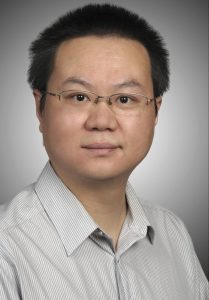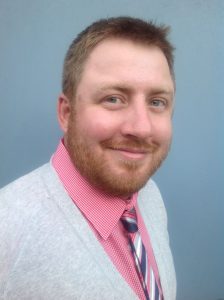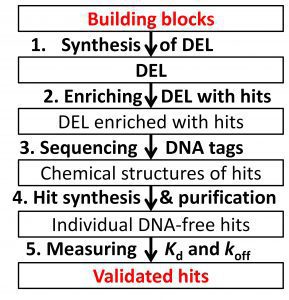Unless otherwise noted, seminars will be hosted in room HEC 125 from 10:00 to 11:30 AM. Virtual talks will have zoom links posted in the calendar and above the speaker’s abstract. If you are out-of-department and wish to attend a virtual seminar, please contact Titel.Jurca@ucf.edu for details.
Prof. Ali Nazemi, University of Quebec at Montreal

(Virtual Seminar) – Zoom Link (10:00 AM)
N-Heterocyclic Carbene-Based Metallopolymers and their Corresponding Metal Nanoparticles
Abstract: Incorporating metal centers into carbon-based polymers has shown to be an effective strategies to access new functional materials with applications in various areas of science and technology.1 To date, metallopolymers incorporating about 30 different metals in combination with a wide range of ligands have been reported. Among the ligand component, multi-dentate N-donors and cyclopentadiene moieties have been widely used.1 However, those based on N-heterocyclic carbenes (NHCs) have been significantly underdeveloped. This is surprising because NHCs are known to form exceptionally strong bonds to a variety of transition metals. In the realm of polymer chemistry, only handful examples of NHC-metal polymers exist.2,3 Our group has recently started working in this area to develop novel approaches to synthesize polymerized NHC-metal complexes. In this presentation, I will discuss some of the advances we have made in accessing such polymers. In addition, the application of these metallopolymers as substrates in the bottom-up fabrication of metal nanoparticles and the stabilities of the resulting materials will be presented.
Host: Titel Jurca
Prof. Denisia Popolan-Vaida & Prof. Matthieu Baudelet
UCF – Department of Chemistry Research Recruitment Talks
(In-Person Seminar) HEC-101 @ 10:00 AM

Ozone an Important Player in Atmospheric and Combustion Chemistry
Abstract: Ozonolysis reactions have been intensively investigated due to their importance in many branches of chemistry such as synthetic organic, atmospheric, and combustion chemistry, but the mechanistic details are not fully understood in part due to limitations in detecting intermediate species. In the reactivity of complex chemical systems, the crucial reaction steps are often determined by highly unstable intermediate species. Often, the intermediates are formed relatively slowly and may react away rapidly, so they are often difficult to isolate and study in detail. The nature of the intermediates can determine the impact of the reaction; for example, in ignition chemistry, the formation of reactive radicals may accelerate ignition while the formation of closed shell species tends to inhibit ignition.
In the first part of the talk, I will show how mass spectrometric methods and synchrotron‑based techniques are used to selectively study individual processes involved in the ozone assisted oxidation reaction of alkenes. An atmospheric pressure jet stirred reactor in conjunction with a high-resolution tunable synchrotron photoionization time-of-flight mass spectrometer is used to monitor the chemical transformations of key intermediates of the reaction of trans-2-butene with ozone via identification and quantification of previously elusive intermediate species. A variety of multi-functional peroxide species are identified based on the experimentally measured photoionization spectra and theoretically determined ionization energies. A reaction network of the Criegee intermediates (CIs) is identified, which is described by the addition of CIs to trans-2-butene, water, and other molecules containing hydroxy, aldehyde, and hydroperoxyl functional groups. In addition, the detection of additional oxygenated species such as methanol, ketene, aldehyde, and acetoin suggest multiple active oxidation routes. These findings improve our understanding of the reaction of alkenes with ozone, providing insights relevant to the formation mechanism of tropospheric aerosol building blocks.
In the second part of the talk, I will show how high-resolution mass spectrometry in conjunction with standard aerosol techniques are used to study the fundamental heterogeneous reaction between short unsaturated dicarboxylic acids aerosol particles and ozone. Low molecular weight dicarboxylic acids, either directly emitted or formed in chemical processes, are found to be a significant component of tropospheric aerosols. Maleic acid was selected as surrogate to assess the potential chemical transformation of short unsaturated dicarboxylic acids in tropospheric heterogeneous chemistry. The experimentally determined reactive uptake coefficient is found to increase with decreasing particle diameter. In addition, cloud condensation nuclei (CCN) activity investigations revealed an increase of the hygroscopicity of maleic acid particle after the reaction with ozone. The rate of change in CCN activity is important to access the role of these particles in cloud formation.

Quantitative forensic analysis: our approach for calibration strategies and trace analysis
Abstract: Forensic analysis keeps evolving because of the increasing ability of our research community to provide information with new approaches and new technology. Nonetheless, in order to provide a reliable information to the judicial system, we need to be able to provide quantitative data. In this talk we will discuss the different aspects of the research performed in my group:
- The elemental analysis of tire evidence shining a new light to road crime forensics with the help of engineers, statisticians and Florida Law Enforcement
- The quantitative analysis of hard biomaterials by laser-ablation techniques providing new tools to Forensic Anthropology and Internal Medicine.
- The multidisciplinary approach to pollen analysis bringing together researchers from chemistry, plant biology, biomedicine and local horticultural gardens
Host: Titel Jurca
Prof. Gang Chen & Prof. Jonathan Caranto
UCF – Department of Chemistry Research Recruitment Talks
(In-Person Seminar)

Towards Precise Control of Plasmonic Nanomaterials: From Synthetic Chemistry to Self-assembly
Abstract: The diversity of materials in structure and properties originates from the 3D arrangement of atoms through chemical bonds which allows atoms to form either large-scale crystals or small molecules. At the nanoscale, aggregates of nanoparticles (NPs) are expected to have unique properties and applications if they can self-assemble like atoms. So far, many literatures have reported the self-assembly of NPs into periodic structures, called superlattices. However, molecular-like NP assemblies are rarely seen due to the absence of valence on their surfaces. In this talk, I will present our work on how to create colloidal analogues of atoms at nanoscale with valence, namely “artificial atoms”, so as to achieve “molecular-type” self-assemblies at nanoscale through the “direct bonding” between “artificial atoms”. More specifically, my talk will show our recent effort on: (1) synthesize NPs with homogeneity in both size and shape like atoms; (2) convert NPs into “artificial atoms” with chemically distinct surface areas that mimic hybridized atomic orbitals, such as sp, sp2, sp3, sp3d, and sp3d2; and (3) realize the molecularization of NPs and their “chemical reactions” to achieve diverse and complex nanostructures. The completion of this work results in: (1) new synthetic approaches and a better understanding of growth mechanism, beneficial to the future customized synthesis of NPs; (2) a better understanding of surface chemistry at nanoscale and developing new surface engineering techniques; (3) enrich the colloidal assembly technique and improve the complexity of colloidal metamaterials. It also provides many exciting opportunities for discovering new applications of nanomaterials in many interdisciplinary research fields.

The enzymatic rise and fall of the nitramine N-nitroglycine
Abstract: There are over 200 N–N bond containing natural products, many of which exhibit intriguing bioactivities. Nitramines (R–N(H)NO2) are critical explosophores in RDX, a common component of military-grade explosives. These functionalities are also found in bacterial natural products, but their physiological role is unknown. To understand the biological function of nitramines, our lab studies the biosynthesis and biodegradation of these groups.
N-nitroglycine (NNG) is a nitramine with weak antibacterial activity made by Streptomyces noursei. The biosynthesis of the nitramine has been proposed to occur via nitration of glycine, perhaps by a nitric oxide dependent pathway. However, the S. noursei genome lacks the genes necessary for such a pathway. Our 15N-isotope labelling studies suggest that NNG is produced via N-oxygenation of hydrazinoacetic acid step. Furthermore, a biosynthetic gene cluster analysis suggests that one function of NNG is to act as biosynthon for larger bacterial natural products.
Alternatively, NNG may act as a transferable nitrogen currency. Variovorax sp. strain JS1663 can grow using NNG as its sole carbon and nitrogen source by degrading it to nitrite and glyoxylate. The enzyme responsible for this degradation was found and called NnlA. Our studies show that NnlA is a heme enzyme that degrades NNG to nitrite, glyoxylate, and ammonium, thereby producing 2 assimilable nitrogen sources. Our results in these two projects may point towards several hypothetical functions for NNG.
Host: Titel Jurca
Prof. Nathalie Wall, University of Florida

(In-Person Seminar)
Technetium Complexation
Abstract: Technetium-99, a predominantly man-made element, can be found in the environment because of nuclear testing, the nuclear reprocessing industry, and nuclear accidents. Tc-99 is found in aqueous systems known to contain halide salts. Although Tc(VII) is thought to be the primary oxidation state of the metal under oxic conditions, Tc(IV) can also be found in the environment due to different reductive pathways. Quantification of thermodynamic parameters associated with the formation of the Tc(IV)-ligands complexes in solution is important to understand the metal behavior in relevant environmental water systems. We will discuss methodologies to obtain such data and relevant results.
Host: Vasileios Anagnostopoulos
Prof. Kevin Stamplecoskie, Queen’s University

(Virtual Seminar) – Zoom Link (10:00 AM)
Photochemistry and Photophysics in the Metal Nanocluster World
Abstract: Metal clusters, with exact numbers of metal atoms and stabilizing ligands, have become a rapidly emerging new area of research. The field offers a great deal of opportunity from new synthesis methods to challenging characterization to photophysical studies of their unique optical and electronic properties.
The structure of several stable clusters will be discussed, as well as several newly isolated materials. The unique properties of clusters will be a main focus in this seminar, especially as they can be tuned by controlling the atomic composition of the materials. These distinctive properties of individual clusters have made them attractive candidates for biomedical imaging, catalysis, photonic devices, and light harvesting. Recent findings in cluster properties as they relate to each of these applications will also be highlighted.

Host: Titel Jurca
Prof. Jeremiah J. Gassensmith, University of Texas at Dallas

(In-Person Seminar)
Crystals in Medicine and Machines
Abstract: In this talk, I show crystalline solid-state materials made from metal-organic frameworks can preserve vaccines and enhance their potency by creating a slow releasing depot of antigens that promote the formation of disease fighting antibodies. I will then make an awkward segue into how molecular crystals not only can show an impressive range of dynamic behaviors including bending, jumping, and exploding but that a new family of crystals we have discovered can act as solid-state muscles capable of doing hundreds of actuation cycles with micronewton forces at just-above-room temperature.
Host: Fernando Uribe-Romo
Prof. Sergey N. Krylov, York University

(In-Person Seminar) HEC-101
Addressing Analytical Challenges of “DNA-Encoded Library” Technology
Abstract: Most therapeutic targets are regulatory or catalytic proteins, and modern drugs are developed to form stable complexes with them. Early-stage drug development aims to obtain and validate a large number of small-molecule hits capable of reversibly binding the target protein with acceptably low and known values of both the rate constant koff and the equilibrium constant Kd = koff/kon in reaction:
During later stages of drug development, validated hits are gradually reduced to pre-clinical leads, clinical candidates, and eventually, a drug.
Developing a single approved drug requires as many as 104 validated hits. Such a large number of them can only be reliably obtained from enormously-diverse combinatorial libraries of small molecules. The most diverse libraries, providing a means of reliable identification of hits, are DNA-encoded libraries (DELs), which are mixtures of up to 1012 compounds each with a DNA tag encoding its chemical structure.

Validated hits are obtained from a DEL in five steps shown in the schematic: 1) synthesis of DEL from building blocks, 2) enriching hits in DEL, 3) sequencing the DNA tags to decode chemical structures of the hits, 4) synthesis/purification of DNA-free hits, and 5) measuring accurate Kd and koff for hit-target complexes.
Steps 1, 2, 4, and 5 currently rely on non-robust processes, which preclude streamlined production of validated hits even if these processes are put on robotic platforms. The non-robustness of these four steps creates costly delays in early-stage drug development. To address this challenge, we are developing four robust processes intended for eventual integration into streamlined manufacturing of validated hits. The 1st process is solid-phase non-aqueous synthesis of DELs from a great diversity of building blocks. The 2nd process is 1-round DEL enrichment with hits of desirably-low koff by capillary electrophoresis. The 3rd process is continuous-flow synthesis/ purification of DNA-free hits by integration of a continuous-flow microreactor with non-aqueous continuous-flow electrophoresis. The 4th process is accurate measurements of Kd and koff for hit–target complexes by combining kinetic chromatography with mass-spectrometry.
In this lecture, I will explain our progress in this ambitious research program. The focus will be made on our recent achievements including: 1-round selection of protein binders from DNA libraries [1–2], non-aqueous continuous-flow electrophoresis [3–5], and accurate measurements of Kd of protein–drug complexes [6–8].
- Le, A.T.H.; Krylova, S.M.; Kanoatov, M.; Desai, S.; Krylov, S.N. Ideal-filter capillary electrophoresis (IFCE) facilitates the one-step selection of aptamers. Chem. Int. Ed. 2019, 58, 2739–2743.
- Le, A.T.H; Krylova, S.M.; Krylov, S.N. Determination of the equilibrium constant and rate constant of protein–oligonucleotide complex dissociation under the conditions of ideal-filter capillary electrophoresis. Chem. 2019, 91, 8532–8539.
- Ivanov, N.A.; Lie, Y.; Kochmann, S.; Krylov, S.N. Non-aqueous continuous-flow electrophoresis (NACFE): separation complement for continuous-flow organic synthesis. Lab Chip2019, 19, 2156–2160.
- Ivanov, N.A.; Kochmann, S.; Krylov, S.N. Visualization of Streams of Small Organic Molecules in Continuous-Flow Electrophoresis. Chem. 2020, 92, 2907–2910.
- Kochmann, S.; Ivanov, N.A.; Lucas, K.S.; Krylov, S.N. Topino: A Graphical Tool for Quantitative Assessment of Molecular Stream Separations. Chem.2021, 93, 9980–9985.
- Sisavath, N.; Rukundo, J.L.; J.C.Y. LeBlanc; Galievsky, V.; Bao, J.; Kochmann, S.; Stasheuski, A.S.; Krylov, S.N. Transient incomplete separation facilitates finding accurate equilibrium dissociation constant of protein–small molecule complex. Chem. Int. Ed. 2019, 58, 6635–6639.
- Rukundo, J.-L.; Le Blanc, J.C.Y.; Kochmann, S.; Krylov, S.N. Assessing Accuracy of an Analytical Method in silico: Application to “Accurate Constant via Transient Incomplete Separation” (ACTIS). Chem. 2020, 92, 11973–11980.
- Rukundo, J.-L.; Kochmann, S.; Wang, T.Y.; Ivanov, N.A.; Le Blanc, J.C.Y.; Gorin, B.I. Krylov, S.N. Template Instrumentation for “Accurate Constant viaTransient Incomplete Separation” (ACTIS). Chem. 2021, 93, accepted.
Host: Dmitry Kolpashchikov
Prof. James W. Leahy, University of South Florida

(In-Person Seminar)
Tools for the Investigation of Infectious Diseases and Neurological Disorders
Abstract: Infectious diseases and neurological disorders are two areas of tremendous need from a drug discovery perspective, and yet both tend to be underserved by the pharmaceutical industry. Our research is focused on the synthesis and development of small molecules that can assist with the treatment and investigation of both of these therapeutic areas.
Host: Cherie Yestrebsky
Prof. Sarah Eddy, Florida International University

(In-Person Seminar)
Exploring how STEM courses influence student success
Abstract: Educational environments interact with STEM students’ motivations and previous experiences to drive their success or attrition in our classes. In this seminar, I will present three case studies each on a different aspect of the educational environment. The first explores the connection between course structures, i.e. implementation of an active learning strategy, and student performance. The second explores how relationships in the classroom can be important for engagement in this active learning. The third case study focuses on classroom content. Specifically, the impact of how instructors present content that relates to students’ personal lives. This case study focuses on trans and genderqueer students in biology classrooms during discussions of sex and gender. Finally, will discuss practical recommendations for instructors based on these three studies.
Host: Erin Saitta
Prof. Alexander Laskin, Purdue University

(In-Person Seminar)
Chemistry of Atmospheric Brown Carbon
Abstract: Light-absorbing organic aerosol commonly termed as Brown carbon (BrC) is a significant contributor to radiative forcing of the Earth’s climate and also is of toxicological concern. Understanding the environmental effects of BrC, its sources, formation, and aging processes requires fundamental knowledge of its chromophores and characterization of their light-absorption properties. This seminar will highlight our recent studies in the area of molecular-level chemistry of BrC that provided first insights into diverse composition and properties of its common chromophores. We present the chemical analysis of chromophores reported in a number of case studies of BrC materials associated with emissions from biomass burning and anthropogenic secondary organic aerosols. The results show that BrC chromophores include organic molecules with various structures, polarities, and volatilities. Understanding their chemical identity requires multi-modal analysis employing complementary separation and ionization approaches in combination with high resolution mass spectrometry. These studies allow assessment of BrC optical properties and relating them to fractional contributions from different classes of chromophores such as aromatic carboxylic acids, nitro-phenols; substituted, heterocyclic and pure polycyclic aromatic hydrocarbons.
Host: Denisia Popolan-Vaida
Prof. Gary E. Douberly, University of Georgia

(In-Person Seminar)
Aggregation in Helium Droplets
Abstract: The first beam of helium droplets was reported in the 1961 paper Strahlen aus kondensiertem Helium im Hochvakuum by Von E. W. Becker and co-workers [1]. However, molecular spectroscopy of helium-solvated dopants wasn’t realized until 30 years later in the laboratories of Scoles and Toennies [2,3].
It has now been over two decades since this early, seminal work on doped helium droplets, yet the field of helium droplet spectroscopy is still fresh with vast potential. Analogous in many ways to cryogenic matrix isolation spectroscopy, the helium droplet is an ideal environment to spectroscopically probe difficult to prepare molecular species, such as radicals, carbenes and ions. The quantum nature of helium at 0.35 K often results in molecular spectra that are sufficiently resolved to evoke an analysis of line shapes and fine-structure that demands rigorous “effective Hamiltonian” treatments. This lecture will focus on our successful attempts to efficiently dope organic molecular radicals and carbenes into helium droplets. The properties of these systems have been probed with infrared laser spectroscopy.
Host: Cherie Yestrebsky
Dr. Lori Ana Valentin, New York State Police Forensic Investigation Center

(In-Person Seminar)
Dynamic Skills for Success
Abstract: “The only difference between a stumbling block and a stepping stone is how you use it.”
This American proverb emphasizes the importance of maintaining a healthy perspective that empowers you to take full advantage of all of your opportunities. As chemists, most of us have embraced the value of hard work and grit. We have high standards and our work is under constant scrutiny. These conditions can lead to perfectionism and even imposter syndrome. Our academic institutions prepare us with the technical skills and intellectual opportunities to be successful, but how prepared are we to navigate the unexpected stressors of life – a pandemic, illness, or loss? Learn how to cultivate and maintain three critical skills for lifelong success: Self-Love, Perspective, and Resilience. This interactive workshop will empower you to address current challenges, overcome future challenges, and find opportunity and inspiration in even the darkest moments.
Host: UCGSA
Dr. Jason C. White, Connecticut Agricultural Experiment Station

(In-Person Seminar)
Tuning agrochemical chemistry at the nanoscale to enhance stress tolerance, crop nutrition and yield
Abstract: Low use and delivery efficiency of conventional agrichemicals is a significant impediment to maintaining global food security, particularly given that a 60-70% increase in food production is needed by 2050 to support the projected population. Further confounding these efforts is a changing climate, which may force increased growth of crops under more marginal and stress-inducing conditions. Thus, novel and sustainable strategies for enhancing food production are needed all along the “farm-to-fork” continuum. We have focused on using nanotechnology to increase the delivery efficiency and efficacy of nutrients. For example, given the known role of micronutrients in plant growth and defense against both abiotic and biotic stresses, we began mechanistic investigations into the potential of nanoscale micronutrient platforms for enhancing nutritional status and disease resistance. In a number of studies, foliar amendment of nanoscale materials such as CuO, CuS, S, and SiO2 have been shown to significantly alleviate damage caused by the fungal and viral pathogens, resulting in enhanced growth and yield. Importantly, disease suppression is largely a function of modulated plant nutrition and disease resistance and not direct toxicity against the pathogen. Separately, we are also looking at novel biopolymer-based nanocomposites as a means to enhance the precision of phosphorus delivery while minimizing run-off and damage to the ecosystem. Other studies are focused on the use of nanoscale metal oxides to enhance photosynthetic efficiency under stressed and non-stressed conditions. Across all of these projects, it is clear that the ability to effectively tune nanoscale material structure and composition will be critical to maximizing positive impacts, including significantly reduced amounts of agrichemical use. Results will be presented from several studies where manipulation of nanoparticle synthesis resulted in tunable and sustainable materials that yielded greater plant health and crop yield by a range of agronomic endpoints.
Host: Swadeshmukul Santra